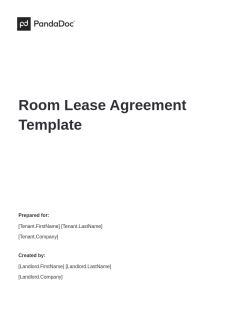Nebraska Room Rental Agreement
A Nebraska Room Rental Agreement is a formal legal document establishing a contractual relationship between a landlord and the tenant, the owner who intends to lease a room. This contract meticulously details the owner and occupant's anticipations and duties. Once this agreement is implemented, it assigns particular responsibilities and obligations to all parties, ensuring a clear understanding of their roles.

Download our professional Nebraska Room Rental Agreementtemplate designed to protect the interests of both parties involved and adhere to state laws.
Legal Aspects
A room rental agreement in Nebraska is a crucial instrument that sets clear expectations and safeguards the rights of both owners and occupants in a cohabitation scenario. It serves as a preventative measure against potential disputes and misunderstandings by recording the specifics of the rental terms.
Access to the Room
- In a Nebraska Room Rental Agreement, the property owner or managing representative can enter the premises during reasonable hours for routine maintenance, provided they give a twenty-four-hour advance notice.
- However, prior notification is waived in emergencies, allowing immediate access to the property. This ensures that urgent issues can be addressed promptly while respecting the tenant’s privacy during normal circumstances.
Please note that these terms are subject to change based on the agreement between the landlord and the tenant.
Guest & Pets Policy
- Liability: Tenants are responsible for any problems caused by their visitors. This is typically stated in the rental agreement.
- Length of Stay: Standard agreements usually don’t permit guests to stay longer than two (2) weeks without the landlord’s written approval.
- Qualification for Tenancy: After a certain period, guest policies often require the guest to be added as a tenant under the lease. State and local laws usually determine the specifics.
- Number of Guests: The landlord may restrict an occupant’s number of visitors at once, often based on local occupancy rules.
- Common Areas: Tenants primarily control private units, while landlords generally manage common areas. These areas are often off-limits to guests without the landlord’s written consent.
Pet Policy:
A Pet Addendum is a legal document that safeguards the landlord and occupant by setting clear rules and expectations.
- Pet Description: It should detail the animal’s type, breed, size, and name.
- Pet Fees and Deposits: These may include any extra fees, pet deposits, or pet rent the tenant needs to pay.
- Pet Rules and Restrictions: It sets rules for pet ownership within the property, like leash requirements and waste cleanup duties.
- Liability: State that the occupant is liable for any damages or injuries caused by their animal.
- Pet Inspections: It might specify when and how the landlord can conduct pet-related inspections.
- Consequences of Violation: It should outline the penalties for breaking the pet-related rules.
- Pet Documentation: It may ask the tenant to provide necessary pet documentation, like proof of vaccinations and licenses.
Security Deposit Regulations
- The landlord can request a security deposit equivalent to a maximum of one (1) month’s rent.
- If the tenant owns a pet, an additional fee can be levied. This fee shouldn’t exceed 25% of the monthly rent.
- Upon the tenant vacating the property, all collected funds, including the security deposit and any additional fees, must be returned within a 14-day period.

